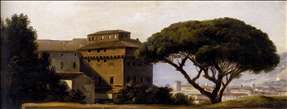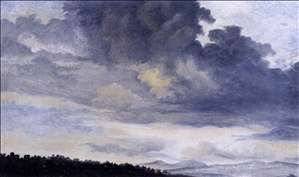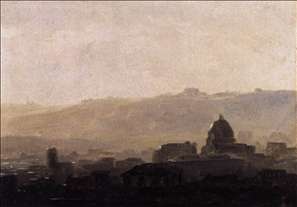French painter. He trained at the academy in Toulouse under the history painter Jean-Baptiste Despax (1709-73). In 1769 he went to Italy for the first time, with Mathias Du Bourg, a councillor at the Toulouse parliament. Du Bourg introduced him to Etienne-Franois, Duc de Choiseul, a keen patron of the arts, who in turn recommended him to Gabriel-Franois Doyen, one of the leading history painters in Paris, whose studio he entered in 1773. Doyen gave his pupil a sense of the elevated ideals of history painting but was also sympathetic to the lesser genre of landscape. Valenciennes presumably frequented Choiseul’s country seat at Chanteloup, near Amboise, meeting there the landscape painters Hubert
Robert and Jean Houel, both protgs of Choiseul. His early interest in the native landscape can be seen in his sketchbooks (Paris, Louvre), especially one dated 1775 that contains drawings made at Amboise, Compiègne and Fontainebleau, and in a later series of oil studies on paper made in Brittany, at the mouth of the River Rance and around St Malo.
Four years later he returned to Rome, journeying in the campagna and through the Kingdom of the Two Sicilies. On this second trip he remained in Italy for four years, dedicating much of his time to the study of perspective under a leading professor of mathematics.
Valenciennes had again returned to Rome by 1785 and, two years later, in 1787, was received at the Royal Academy in Paris. His reception painting was an historical subject set in a landscape, Cicero cutting down the trees which hid the tomb of Archimedes (Paris, Louvre on deposit in Toulouse, Muse des Augustins), a singularly appropriate subject for an artist who had chosen to adapt mathematical formulae to painting. This work was also presented at the Salon that year, along with his Ancient Town of Agrigento (Paris, Louvre), Landscape of Ancient Greece (dated 1786, and now in Detroit, Institute of Fine Arts), and Landscape with an ancient town, and two women offering flowers to the Nayads of a fountain (lost). Although he was already thirty-seven years old there are no surviving dated oil paintings that predate these works. Two years later he presented what might be considered his masterpiece, A Capriccio of Rome with the Finish of a Marathon (San Francisco, Museum of Fine Arts), exhibited at the Salon under the title Landscape Representing an Ancient City.
With his reception at the Academy he opened his own studio, being appointed to the new post of Professor of Perspective at the cole des Beaux-Arts in 1796 (until 1800).
While Valenciennes shares with Houel and
Hackert the credit for elevating the status of landscape painting, the paysage historique itself was really his invention. At the turn of the century he began to lighten his palette, using more oil and a brushier, less polished technique while his approach became more decorative, with fewer historical themes.



